文章目录
1. 数组、链表、树的存储方式分析
为什么要需要树这种数据结构?
先分析一下数组、链表的存储方式
1.1. 数组的存储方式
优点:通过下标方式访问元素,速度快。对于有序数组,还可使用二分查找提高检索速度。
缺点:如果要检索具体某个值,或者插入值(按一定顺序)会整体移动,效率较低 [示意图]
操作示意图:
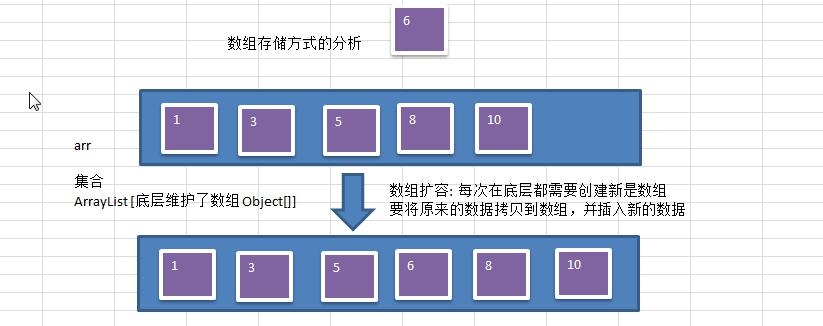
1.2. 链式存储方式
优点:在一定程度上对数组存储方式有优化(比如:插入一个数值节点,只需要将插入节点,链接到链表中即可,删除效率也很好)。
缺点:在进行检索时,效率仍然较低,比如(检索某个值,需要从头节点开始遍历) 【示意图】
操作示意图:
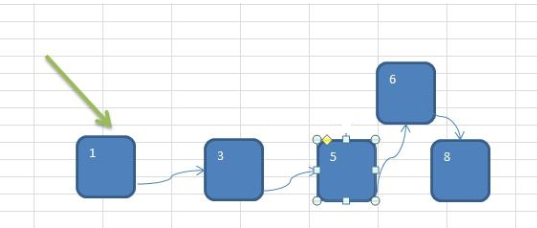
1.3. 树的存储方式
能提高数据存储,读取的效率, 比如利用 二叉排序树(Binary Sort Tree),既可以保证数据的检索速度,同时也可以保证数据的插入,删除,修改的速度。【示意图,后面详讲】
操作示意图:
案例: [7, 3, 10, 1, 5, 9, 12]
注意:树的排列顺序,左边节点比中间小,右边节点比中间大

2. 树的相关概念
2.1. 树的常用术语
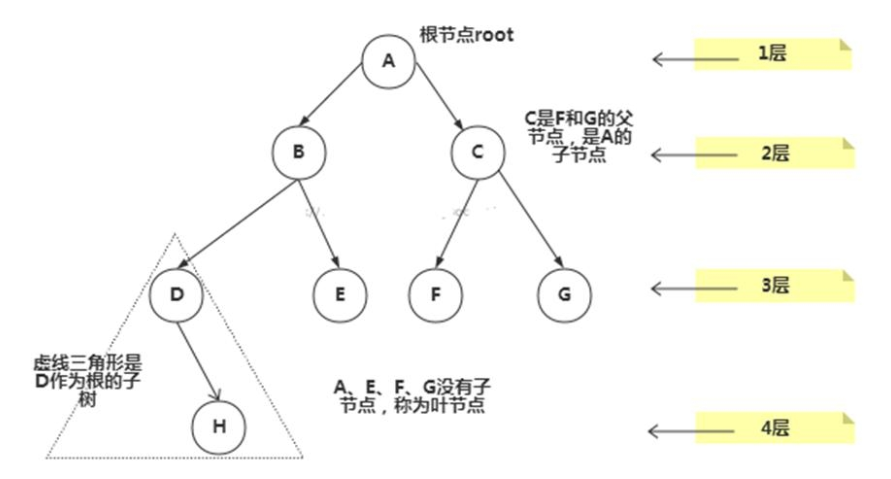
树的常用术语(结合示意图理解):
- 节点
- 根节点
- 父节点
- 子节点
- 叶子节点 (没有子节点的节点)
- 节点的权(节点值)
- 路径(从 root 节点找到该节点的路线)
- 层
- 子树
- 树的高度(最大层数)
- 森林 :多颗子树构成森林
2.2. 二叉树的概念
- 树有很多种,每个节点最多只能有两个子节点的一种形式称为二叉树。
- 二叉树的子节点分为左节点和右节点
示意图:

- 如果该二叉树的所有叶子节点都在最后一层,并且 节点总数 = 2 n − 1 节点总数= 2^n -1 节点总数=2n−1 , n n n 为层数,则我们称为满二叉树。

- 如果该二叉树的所有叶子节点都在最后一层或者倒数第二层,而且最后一层的叶子节点在左边连续,倒数第二层的叶子节点在右边连续,我们称为完全二叉树。

3. 二叉树遍历
使用前序,中序和后序对下面的二叉树进行遍历.
- 前序遍历: 先输出父节点,再遍历左子树和右子树
- 中序遍历: 先遍历左子树,再输出父节点,再遍历右子树
- 后序遍历: 先遍历左子树,再遍历右子树,最后输出父节点
小结: 看输出父节点的顺序,就确定是前序,中序还是后序
3.1. 思路分析
应用实例的说明和思路:

3.1.1. 代码实现
package tree;
import java.util.Objects;
public class BinaryTreeDemo {
public static void main(String[] args) {
// 创建一棵二叉树
BinaryTree binaryTree = new BinaryTree();
// 创建需要的节点
HeroNode root = new HeroNode(1, "宋江");
HeroNode node2 = new HeroNode(2, "吴用");
HeroNode node3 = new HeroNode(3, "卢俊义");
HeroNode node4 = new HeroNode(4, "林冲");
// 说明:我们先手动创建该二叉树,后面我们学习递归的方式创建二叉树
root.setLeft(node2);
root.setRight(node3);
node3.setRight(node4);
binaryTree.setRoot(root);
// 测试前序遍历
System.out.println("前序遍历");// 1,2,3,4
binaryTree.preOrder();
// 测试中序遍历
System.out.println("中序遍历");// 2,1,3,4
binaryTree.infixOrder();
// 测试后序遍历
System.out.println("后序遍历");// 2,4,3,1
binaryTree.postOrder();
}
}
// 定义一个BinaryTree二叉树
class BinaryTree {
private HeroNode root;
public void setRoot(HeroNode root) {
this.root = root;
}
// 前序遍历
public void preOrder() {
if (this.root != null) {
this.root.preOder();
} else {
System.out.println("二叉树为空,无法遍历");
}
}
// 中序遍历
public void infixOrder() {
if (this.root != null) {
this.root.infixOrde();
} else {
System.out.println("二叉树为空,无法遍历");
}
}
// 后序遍历
public void postOrder() {
if (this.root != null) {
this.root.postOrder();
} else {
System.out.println("二叉树为空,无法遍历");
}
}
}
// 先创建HeroNode节点
class HeroNode {
private int no;
private String name;
private HeroNode left;// 默认null
private HeroNode right;// 默认null
public HeroNode(int no, String name) {
super();
this.no = no;
this.name = name;
}
public int getNo() {
return this.no;
}
public void setNo(int no) {
this.no = no;
}
public String getName() {
return this.name;
}
public void setName(String name) {
this.name = name;
}
public HeroNode getLeft() {
return this.left;
}
public void setLeft(HeroNode left) {
this.left = left;
}
public HeroNode getRight() {
return this.right;
}
public void setRight(HeroNode right) {
this.right = right;
}
@Override
public String toString() {
return "HeroNode [no=" + no + ", name=" + name + "]";
}
// 编写前序遍历的方法
public void preOder() {
System.out.println(this);// 先输出父节点
// 递归向左子树前序遍历
if (this.left != null) {
this.left.preOder();
}
// 递归向右子树前序遍历
if (this.right != null) {
this.right.preOder();
}
}
// 编写中序遍历的方法
public void infixOrde() {
// 递归向左子树中序遍历
if (this.left != null) {
this.left.infixOrde();
}
// 输出父节点
System.out.println(this);
// 递归向右子树中序遍历
if (this.right != null) {
this.right.infixOrde();
}
}
// 编写后序遍历的方法
public void postOrder() {
if (this.left != null) {
this.left.postOrder();
}
if (this.right != null) {
this.right.postOrder();
}
System.out.println(this);
}
}
运行结果:

3.2. 问题拓展
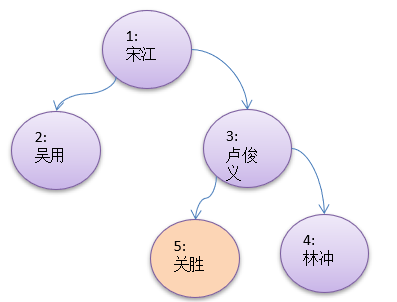
前上图的 3号节点 “卢俊” , 增加一个左子节点 [5, 关胜]
使用前序,中序,后序遍历,请写出各自输出的顺序是什么?
代码实现:
package tree;
import java.util.Objects;
public class BinaryTreeDemo {
public static void main(String[] args) {
// 创建一棵二叉树
BinaryTree binaryTree = new BinaryTree();
// 创建需要的节点
HeroNode root = new HeroNode(1, "宋江");
HeroNode node2 = new HeroNode(2, "吴用");
HeroNode node3 = new HeroNode(3, "卢俊义");
HeroNode node4 = new HeroNode(4, "林冲");
HeroNode node5 = new HeroNode(5, "关胜");
// 说明:我们先手动创建该二叉树,后面我们学习递归的方式创建二叉树
root.setLeft(node2);
root.setRight(node3);
node3.setRight(node4);
node3.setLeft(node5);
binaryTree.setRoot(root);
// 测试前序遍历
System.out.println("前序遍历");// 1,2,3,4
binaryTree.preOrder();
// 测试中序遍历
System.out.println("中序遍历");// 2,1,3,4
binaryTree.infixOrder();
// 测试后序遍历
System.out.println("后序遍历");// 2,4,3,1
binaryTree.postOrder();
}
}
// 定义一个BinaryTree二叉树
class BinaryTree {
private HeroNode root;
public void setRoot(HeroNode root) {
this.root = root;
}
// 前序遍历
public void preOrder() {
if (this.root != null) {
this.root.preOrder();
} else {
System.out.println("二叉树为空,无法遍历");
}
}
// 中序遍历
public void infixOrder() {
if (this.root != null) {
this.root.infixOrder();
} else {
System.out.println("二叉树为空,无法遍历");
}
}
// 后序遍历
public void postOrder() {
if (this.root != null) {
this.root.postOrder();
} else {
System.out.println("二叉树为空,无法遍历");
}
}
}
// 先创建HeroNode节点
class HeroNode {
private int no;
private String name;
private HeroNode left;// 默认null
private HeroNode right;// 默认null
public HeroNode(int no, String name) {
super();
this.no = no;
this.name = name;
}
public int getNo() {
return this.no;
}
public void setNo(int no) {
this.no = no;
}
public String getName() {
return this.name;
}
public void setName(String name) {
this.name = name;
}
public HeroNode getLeft() {
return this.left;
}
public void setLeft(HeroNode left) {
this.left = left;
}
public HeroNode getRight() {
return this.right;
}
public void setRight(HeroNode right) {
this.right = right;
}
@Override
public String toString() {
return "HeroNode [no=" + no + ", name=" + name + "]";
}
// 编写前序遍历的方法
public void preOrder() {
System.out.println(this);// 先输出父节点
// 递归向左子树前序遍历
if (this.left != null) {
this.left.preOrder();
}
// 递归向右子树前序遍历
if (this.right != null) {
this.right.preOrder();
}
}
// 编写中序遍历的方法
public void infixOrder() {
// 递归向左子树中序遍历
if (this.left != null) {
this.left.infixOrder();
}
// 输出父节点
System.out.println(this);
// 递归向右子树中序遍历
if (this.right != null) {
this.right.infixOrder();
}
}
// 编写后序遍历的方法
public void postOrder() {
if (this.left != null) {
this.left.postOrder();
}
if (this.right != null) {
this.right.postOrder();
}
System.out.println(this);
}
}
运行结果:
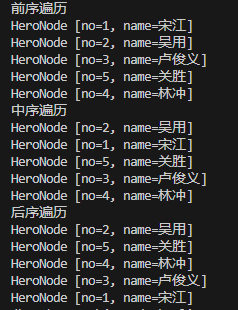
4. 二叉树查找指定节点
要求:
①请编写前序查找,中序查找和后序查找的方法。
②并分别使用三种查找方式,查找 heroNO = 5 的节点
③并分析各种查找方式,分别比较了多少次
4.1. 思路分析
思路分析图解:
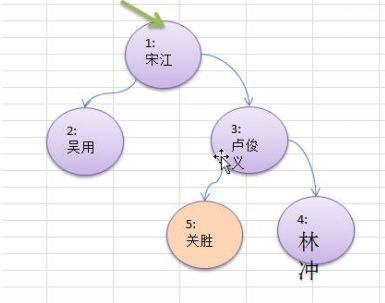
使用前序,中序,后序的方式来查询指定的结点
前序查找思路:
1.先判断当前节点的no是否等于要查找的
2.如果是相等,则返回当前节点
3.如果不等,则判断当前节点的左子节点是否为空,如果不为空,则递归前序查找
4.如果左递归前序查找,找到节点,则返回,否继续判断,当前的节点的右子节点是否为空,如果不空,则继续向右递归前序查找.
中序查找思路:
1.判断当前节点的左子节点是否为空,如果不为空,则递归中序查找
2.如果找到,则返回,如果没有找到,就和当前结点比较,如果是则返回当前节点,否则继续进行右递归的中序查找
3.如果右递归中序查找,找到就返回,否则返回null
后序查找思路:
1判断当前节点的左子节点是否为空,如果不为空,则递归后序查找
2.如果找到,就返回,如果没有找到,就判断当前节点的右子节点是否为空,如果不为空,则右递归进行后序查找,如果找到,就返回
3.就和当前节点进行比较,比如,如果是则返回,否则返回null
4.2. 代码实现
package tree;
import java.util.Objects;
public class BinaryTreeDemo {
public static void main(String[] args) {
// 创建一棵二叉树
BinaryTree binaryTree = new BinaryTree();
// 创建需要的节点
HeroNode root = new HeroNode(1, "宋江");
HeroNode node2 = new HeroNode(2, "吴用");
HeroNode node3 = new HeroNode(3, "卢俊义");
HeroNode node4 = new HeroNode(4, "林冲");
HeroNode node5 = new HeroNode(5, "关胜");
// 说明:我们先手动创建该二叉树,后面我们学习递归的方式创建二叉树
root.setLeft(node2);
root.setRight(node3);
node3.setRight(node4);
node3.setLeft(node5);
binaryTree.setRoot(root);
// 测试前序遍历
System.out.println("前序遍历");// 1,2,3,4
binaryTree.preOrder();
// 测试中序遍历
System.out.println("中序遍历");// 2,1,3,4
binaryTree.infixOrder();
// 测试后序遍历
System.out.println("后序遍历");// 2,4,3,1
binaryTree.postOrder();
// 前序遍历:4次
// System.out.println("前序遍历方式");
// HeroNode resNode = binaryTree.preOrderSearch(5);
// if (resNode != null) {
// System.out.printf("找到了,信息为 no=%d name=%s", resNode.getNo(),
// resNode.getName());
// }else{
// System.out.printf("没有找到 no=%d 的英雄", 5);
// }
// 中序遍历:3次
// System.out.println("中序遍历方式");
// HeroNode resNode = binaryTree.infixOrderSearch(5);
// if (resNode != null) {
// System.out.printf("找到了,信息为 no=%d name=%s", resNode.getNo(),
// resNode.getName());
// }else{
// System.out.printf("没有找到 no=%d 的英雄", 5);
// }
// 后序遍历:2次
System.out.println("后序遍历方式");
HeroNode resNode = binaryTree.postOrderSearch(5);
if (resNode != null) {
System.out.printf("找到了,信息为 no=%d name=%s", resNode.getNo(), resNode.getName());
} else {
System.out.printf("没有找到 no=%d 的英雄", 5);
}
}
}
// 定义一个BinaryTree二叉树
class BinaryTree {
private HeroNode root;
public void setRoot(HeroNode root) {
this.root = root;
}
// 前序遍历
public void preOrder() {
if (this.root != null) {
this.root.preOrder();
} else {
System.out.println("二叉树为空,无法遍历");
}
}
// 中序遍历
public void infixOrder() {
if (this.root != null) {
this.root.infixOrder();
} else {
System.out.println("二叉树为空,无法遍历");
}
}
// 后序遍历
public void postOrder() {
if (this.root != null) {
this.root.postOrder();
} else {
System.out.println("二叉树为空,无法遍历");
}
}
// 前序遍历查找
public HeroNode preOrderSearch(int no) {
if (root != null) {
return root.preOrderSearch(no);
} else {
return null;
}
}
// 中序遍历
public HeroNode infixOrderSearch(int no) {
if (root != null) {
return root.infixOrderSearch(no);
} else {
return null;
}
}
// 后序遍历
public HeroNode postOrderSearch(int no) {
if (root != null) {
return this.root.postOrderSearch(no);
} else {
return null;
}
}
}
// 先创建HeroNode节点
class HeroNode {
private int no;
private String name;
private HeroNode left;// 默认null
private HeroNode right;// 默认null
public HeroNode(int no, String name) {
super();
this.no = no;
this.name = name;
}
public int getNo() {
return this.no;
}
public void setNo(int no) {
this.no = no;
}
public String getName() {
return this.name;
}
public void setName(String name) {
this.name = name;
}
public HeroNode getLeft() {
return this.left;
}
public void setLeft(HeroNode left) {
this.left = left;
}
public HeroNode getRight() {
return this.right;
}
public void setRight(HeroNode right) {
this.right = right;
}
@Override
public String toString() {
return "HeroNode [no=" + no + ", name=" + name + "]";
}
// 编写前序遍历的方法
public void preOrder() {
System.out.println(this);// 先输出父节点
// 递归向左子树前序遍历
if (this.left != null) {
this.left.preOrder();
}
// 递归向右子树前序遍历
if (this.right != null) {
this.right.preOrder();
}
}
// 编写中序遍历的方法
public void infixOrder() {
// 递归向左子树中序遍历
if (this.left != null) {
this.left.infixOrder();
}
// 输出父节点
System.out.println(this);
// 递归向右子树中序遍历
if (this.right != null) {
this.right.infixOrder();
}
}
// 编写后序遍历的方法
public void postOrder() {
if (this.left != null) {
this.left.postOrder();
}
if (this.right != null) {
this.right.postOrder();
}
System.out.println(this);
}
// 前序遍历查找
/**
*
* @param no 查找的编号
* @return 如果找到就返回该Node,如果没有找到就返回null
*/
public HeroNode preOrderSearch(int no) {
System.out.println("进入了前序查找一次~~");
// 比较当前节点是不是
if (this.no == no) {
return this;
}
// 1. 判断当前节点的左子节点是否为空,如果不为空,则递归前序查找
// 2. 如果左递归前序查找,找到节点,则返回
HeroNode resNode = null;
if (this.left != null) {
resNode = this.left.preOrderSearch(no);
}
if (resNode != null) {// 说明我们左子树找到
return resNode;
}
// 1. 左递归前序查找,找到节点,则返回,否继续判断,
// 2.当前的节点的右子节点是否为空,如果不空,则继续向右递归前序查找
if (this.right != null) {
resNode = this.right.preOrderSearch(no);
}
return resNode;
}
// 中序遍历查找
public HeroNode infixOrderSearch(int no) {
// 判断当前节点的左子节点是否为空,如果不为空,则递归中序查找
HeroNode resNode = null;
if (this.left != null) {
resNode = this.left.infixOrderSearch(no);
}
if (resNode != null) {
return resNode;
}
System.out.println("进入了中序查找一次~~");
// 如果找到,则返回,如果没有找到,就和当前结点比较,如果是则返回当前节点
if (this.no == no) {
return this;
}
// 否则继续进行右递归的中序查找
if (this.right != null) {
resNode = this.right.infixOrderSearch(no);
}
return resNode;
}
// 后序遍历查找
public HeroNode postOrderSearch(int no) {
// 判断当前节点的左节点是否为空,如果不为空,则递归后序查找
HeroNode resNode = null;
if (this.left != null) {
resNode = this.left.postOrderSearch(no);
}
if (resNode != null) {// 说明在左子树找到
return resNode;
}
// 如果左子树没有找到,则向右子树递归进行后序遍历查找
if (this.right != null) {
resNode = this.right.postOrderSearch(no);
}
if (resNode != null) {
return resNode;
}
System.out.println("进入了后序查找一次~~");
// 如果左右子树都没有找到,就比较当前节点是不是
if (this.no == no) {
return this;
}
return resNode;
}
}
运行结果:

5. 二叉树删除指定节点
要求:
①如果删除的节点是叶子节点,则删除该节点
②如果删除的节点是非叶子节点,则删除该子树
实现,删除掉 5 号叶子节点 和 3 号子树.
5.1. 思路分析
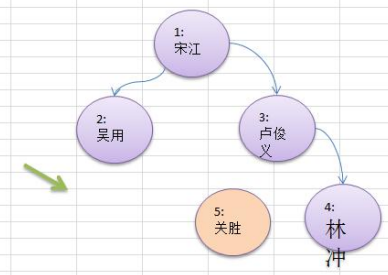
思路 :
首先考虑:如果只有一个root结点,则等价将二叉树置空
// 然后进行下面步骤
1.因为我们的二叉树是单向的,所以我们是判断当前节点的子节点是否需要删除结点,而不能去判断当前这个节点是不是需要删除节点。
2.如果当前节点的左子节点不为空,并且左子节点就是要删除节点,就将this.left=null,并且就返回(结束递归删除)
3.如果当前节点的右子节点不为空,并且右子节点就是要删除节点,就将this.right=null,并且就返回(结束递归删除)
4.如果第2和第3步没有删除节点,那么就需要向左子树进行递归删除
5.如果第4步也没有删除节点,则应当向右子树进行递归删除
5.2. 代码实现
package tree;
import java.util.Objects;
public class BinaryTreeDemo {
public static void main(String[] args) {
// 创建一棵二叉树
BinaryTree binaryTree = new BinaryTree();
// 创建需要的节点
HeroNode root = new HeroNode(1, "宋江");
HeroNode node2 = new HeroNode(2, "吴用");
HeroNode node3 = new HeroNode(3, "卢俊义");
HeroNode node4 = new HeroNode(4, "林冲");
HeroNode node5 = new HeroNode(5, "关胜");
// 说明:我们先手动创建该二叉树,后面我们学习递归的方式创建二叉树
root.setLeft(node2);
root.setRight(node3);
node3.setRight(node4);
node3.setLeft(node5);
binaryTree.setRoot(root);
// 删除节点
System.out.println("删除前,前序遍历");
binaryTree.preOrder();// 1,2,3,5,4
binaryTree.delNode(5);
// binaryTree.delNode(3);
System.out.println("删除后,前序遍历");
binaryTree.preOrder();// 1,2,3,4
}
}
// 定义一个BinaryTree二叉树
class BinaryTree {
private HeroNode root;
public void setRoot(HeroNode root) {
this.root = root;
}
// 删除节点
public void delNode(int no) {
if (root != null) {
// 如果只有一个root节点,这里立即判断root是不是就是要删除的节点
if (root.getNo() == no) {
root = null;
} else {
// 递归删除
root.delNode(no);
}
} else {
System.out.println("空数,不能删除~");
}
}
// 前序遍历
public void preOrder() {
if (this.root != null) {
this.root.preOrder();
} else {
System.out.println("二叉树为空,无法遍历");
}
}
// 中序遍历
public void infixOrder() {
if (this.root != null) {
this.root.infixOrder();
} else {
System.out.println("二叉树为空,无法遍历");
}
}
// 后序遍历
public void postOrder() {
if (this.root != null) {
this.root.postOrder();
} else {
System.out.println("二叉树为空,无法遍历");
}
}
// 前序遍历查找
public HeroNode preOrderSearch(int no) {
if (root != null) {
return root.preOrderSearch(no);
} else {
return null;
}
}
// 中序遍历
public HeroNode infixOrderSearch(int no) {
if (root != null) {
return root.infixOrderSearch(no);
} else {
return null;
}
}
// 后序遍历
public HeroNode postOrderSearch(int no) {
if (root != null) {
return this.root.postOrderSearch(no);
} else {
return null;
}
}
}
// 先创建HeroNode节点
class HeroNode {
private int no;
private String name;
private HeroNode left;// 默认null
private HeroNode right;// 默认null
public HeroNode(int no, String name) {
super();
this.no = no;
this.name = name;
}
public int getNo() {
return this.no;
}
public void setNo(int no) {
this.no = no;
}
public String getName() {
return this.name;
}
public void setName(String name) {
this.name = name;
}
public HeroNode getLeft() {
return this.left;
}
public void setLeft(HeroNode left) {
this.left = left;
}
public HeroNode getRight() {
return this.right;
}
public void setRight(HeroNode right) {
this.right = right;
}
@Override
public String toString() {
return "HeroNode [no=" + no + ", name=" + name + "]";
}
// 递归删除节点
// 1. 如果删除的节点是叶子节点,则删除该节点
// 2. 如果删除的节点是非叶子节点,则删除该子树
public void delNode(int no) {
// 思路
/*
* 1.因为我们的二叉树是单向的,所以我们是判断当前节点的子节点是否需要删除结点,而不能去判断当前这个节点是不是需要删除节点。
* 2.如果当前节点的左子节点不为空,并且左子节点就是要删除节点,就将this.left=null,并且就返回(结束递归删除)
* 3.如果当前节点的右子节点不为空,并且右子节点就是要删除节点,就将this.right=null,并且就返回(结束递归删除)
* 4.如果第2和第3步没有删除节点,那么就需要向左子树进行递归删除
* 5.如果第4步也没有删除节点,则应当向右子树进行递归删除
*/
// 2.如果当前节点的左子节点不为空,并且左子节点就是要删除节点,就将this.left=null,并且就返回(结束递归删除)
if (this.left != null && this.left.no == no) {
this.left = null;
return;
}
// 3.如果当前节点的右子节点不为空,并且右子节点就是要删除节点,就将this.right=null,并且就返回(结束递归删除)
if (this.right != null && this.right.no == no) {
this.right = null;
return;
}
// 4.如果第2和第3步没有删除节点,那么就需要向左子树进行递归删除
if (this.left != null) {
this.left.delNode(no);
}
// 5.如果第4步也没有删除节点,则应当向右子树进行递归删除
if (this.right != null) {
this.right.delNode(no);
}
}
// 编写前序遍历的方法
public void preOrder() {
System.out.println(this);// 先输出父节点
// 递归向左子树前序遍历
if (this.left != null) {
this.left.preOrder();
}
// 递归向右子树前序遍历
if (this.right != null) {
this.right.preOrder();
}
}
// 编写中序遍历的方法
public void infixOrder() {
// 递归向左子树中序遍历
if (this.left != null) {
this.left.infixOrder();
}
// 输出父节点
System.out.println(this);
// 递归向右子树中序遍历
if (this.right != null) {
this.right.infixOrder();
}
}
// 编写后序遍历的方法
public void postOrder() {
if (this.left != null) {
this.left.postOrder();
}
if (this.right != null) {
this.right.postOrder();
}
System.out.println(this);
}
// 前序遍历查找
/**
*
* @param no 查找的编号
* @return 如果找到就返回该Node,如果没有找到就返回null
*/
public HeroNode preOrderSearch(int no) {
System.out.println("进入了前序查找一次~~");
// 比较当前节点是不是
if (this.no == no) {
return this;
}
// 1. 判断当前节点的左子节点是否为空,如果不为空,则递归前序查找
// 2. 如果左递归前序查找,找到节点,则返回
HeroNode resNode = null;
if (this.left != null) {
resNode = this.left.preOrderSearch(no);
}
if (resNode != null) {// 说明我们左子树找到
return resNode;
}
// 1. 左递归前序查找,找到节点,则返回,否继续判断,
// 2.当前的节点的右子节点是否为空,如果不空,则继续向右递归前序查找
if (this.right != null) {
resNode = this.right.preOrderSearch(no);
}
return resNode;
}
// 中序遍历查找
public HeroNode infixOrderSearch(int no) {
// 判断当前节点的左子节点是否为空,如果不为空,则递归中序查找
HeroNode resNode = null;
if (this.left != null) {
resNode = this.left.infixOrderSearch(no);
}
if (resNode != null) {
return resNode;
}
System.out.println("进入了中序查找一次~~");
// 如果找到,则返回,如果没有找到,就和当前结点比较,如果是则返回当前节点
if (this.no == no) {
return this;
}
// 否则继续进行右递归的中序查找
if (this.right != null) {
resNode = this.right.infixOrderSearch(no);
}
return resNode;
}
// 后序遍历查找
public HeroNode postOrderSearch(int no) {
// 判断当前节点的左节点是否为空,如果不为空,则递归后序查找
HeroNode resNode = null;
if (this.left != null) {
resNode = this.left.postOrderSearch(no);
}
if (resNode != null) {// 说明在左子树找到
return resNode;
}
// 如果左子树没有找到,则向右子树递归进行后序遍历查找
if (this.right != null) {
resNode = this.right.postOrderSearch(no);
}
if (resNode != null) {
return resNode;
}
System.out.println("进入了后序查找一次~~");
// 如果左右子树都没有找到,就比较当前节点是不是
if (this.no == no) {
return this;
}
return resNode;
}
}
运行结果:
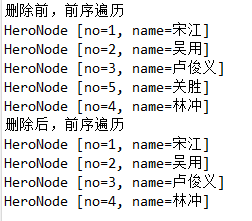
思考题:
如果要删除的节点是非叶子节点,现在不希望将该非叶子节点为根节点的子树删除,需要指定规则, 假如规定如下:
①如果该非叶子节点 A 只有一个子节点 B,则子节点 B 替代节点 A
②如果该非叶子节点 A 有左子节点 B 和右子节点 C,则让左子节点 B 替代节点 A。
请思考,如何完成该删除功能,在后面二叉排序树中,讲解具体的删除方法
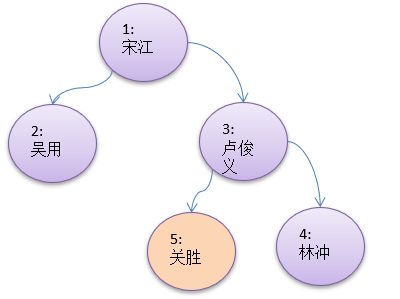






















 4229
4229











 被折叠的 条评论
为什么被折叠?
被折叠的 条评论
为什么被折叠?










